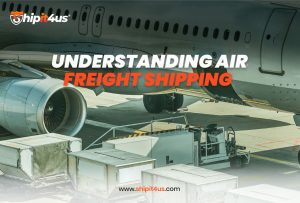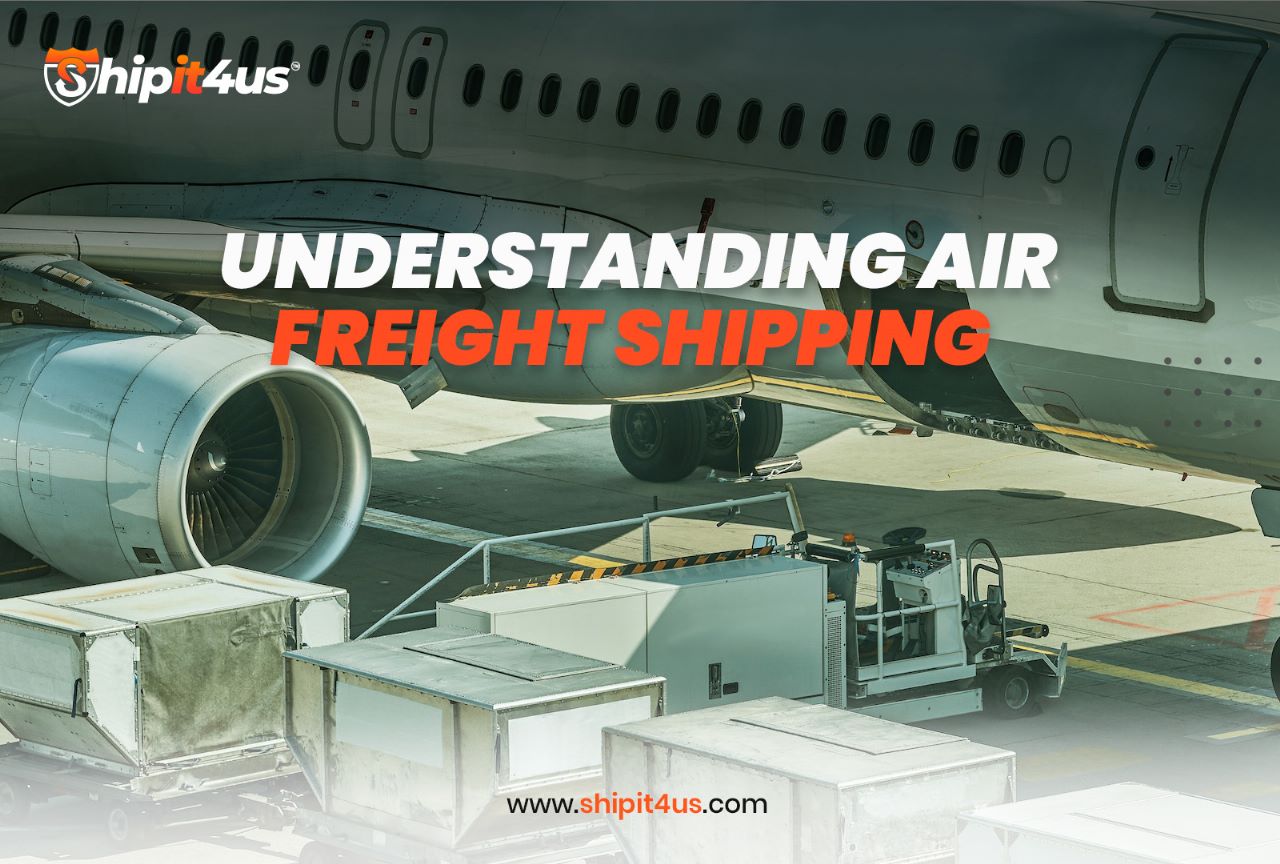
By easing their air freight shipping processes, Shipit4us, a dependable and trusted online shipping/transport marketplace, aids small and medium-sized businesses in growing. We are here to connect your company to the rest of the world, whether you are shipping freight internationally or transferring items across a continent.
Table of Contents
What is Air Freight?
The transfer and transportation of products by an air carrier—charter or commercial—is known as air freight package delivery. Anywhere that airplanes can fly and land is where these products are transferred from gateways for commercial and passenger aviation.
Air freight has a number of advantages over ocean freight for your business.Air freight may deliver your goods to their destination faster—and on a more accurate schedule—in addition to exposing your cargo to less handling, which can translate to a decreased likelihood of damage.
There are differences between express freight shipments and international air freight.
Express air freight is often handled by a single company (like DHL, UPS, or FedEx), which manages the entire shipment lifecycle and has a door-to-door delivery time of fewer than five days. Compared to air freight, express air freight shipments are frequently smaller (less than 1 cubic meter and 200 kg). Larger and more diverse carriers are able to transport significantly larger international air freight goods. The largest freight plane, the Anatov 225, can actually hold an entire train.
During a regular season, the cost of sending freight internationally by air can range from $2.50 to $5.00 per kilogram, depending on the kind of item you’re sending and the amount of available space. However, prices have dramatically escalated since February 2020 as a result of significant disruptions in ocean freight and rising consumer demand.
The current price range for air cargo is $4–$8 per kilogram.
Growth of Air Freight Shipping
When paired with other forms of shipping like sea, rail, and ground, air freight became one of the most popular delivery options for importing and exporting starting in the early 20th century.Due to the expansion of trade networks and markets over the past 40 years, the air freight business has experienced exponential growth, and it is now acknowledged as a reliable means of moving goods both domestically and internationally.
Costs and rates for air freight shipping
Important factors in shipping air freight include weight and volume. Airlines will either charge by volumetric weight (also known as dimensional weight) or actual weight, depending on which is more expensive.
The item’s cubic meter volume should be multiplied by 167 to determine the volumetric weight for air shipping. Let’s imagine you have a package that is 40 cm wide, 40 cm high, and 40 cm long. As a result, the volume is.064 (the product of all sides divided by one million). You may get a volumetric weight of 10.67 kg by multiplying this by 167.
Advantages of air freight
Three main benefits of air shipping include:
Speed-
Speed-wise, airplanes outpace ocean liners by about 30 times. While ocean liners steam gently at 16 to 18 mph, passenger jets go at 575 mph.
Reliability – Air shipping offers better tracking and greater assurance that your items will arrive at their destination on schedule.
Protection – Compared to air freight, goods going by the ocean are more likely to sustain damage. Therefore, it is a terrific option for fragile items.
When should I avoid shipping by air?
The following are some drawbacks of air transportation:
Cost – Compared to ocean freight, air freight carries a heavy price tag.
CO2 emissions – Air freight has far higher emissions.
Heavy Shipments –
Large, heavy objects are easily transported in shipping containers, which have been a staple of the freight shipping industry since the 1960s. The cost of air freight is determined by size and weight, which can drastically increase costs.
What products are typically transported by air freight?
Air freight is often only utilized for smaller, more precious items or those that need to be delivered rapidly because of its high cost, such as:
Electronics. In order to transport the first iMac before the holiday season, Steve Jobs is credited with purchasing all of the available air freight capacity along important Asia-US lines.
Apparel. Clothing seasonal trends can change quickly. Therefore, it is frequently necessary to move clothing as quickly as possible from producers to stores.
Pharmaceuticals. Since medical supplies are expensive and small, they are usually transported by air.
Seasonal deliveries. Whatever the product, if there is a big global demand for it and it needs to be supported farther along the supply chain, it will often be supplied by air.
Rates & fees for air freight shipment
Beyond the cost of air freight, which is computed based on the pricing above, the total cost of shipping by air is likely to also include:
Fuel escalations
Surcharges for security
Container freight handling fees at the station or terminal
Airport shuttles
Six Best Practices for Air Freight Shipping
1. Put a Label
When shipments of air freight are poorly labeled, we have the most issues. The swift turnaround that air shipping is known for could be delayed as a result of your box being lost, abandoned, or mistakenly added to someone else’s shipment.Unclear labeling for foreign goods might also result in a delay in customs clearance, which can be quite frustrating.
- A Commercial Invoice for International Shipments should be included
Be sure to create a commercial invoice if your shipment is traveling overseas. Without one, customs can delay your items. In the worst instance, you can even incur fines or storage fees while the product is being held for proper documentation.
- Corrugated Fiberboard Boxes Should Not Be Reused
It can be tempting to reuse a box if it was shipped out in perfect shape. But there is a slight danger in doing this. These boxes occasionally lack the durability to sustain repeated use without breaking. Additionally, they are highly sensitive to humidity and rain, which can severely damage their structure.
- Prepare and properly pack your boxes
Despite the fact that cardboard fiberboard boxes are a great option for air freight shipments, they are susceptible to crushing, especially if you leave significant air pockets surrounding your cargo.
Even if your cargo is handled less by air freight than by ocean freight, there could still be some effects along the way. This typically occurs when your cargo is moved from a truck to a plane and back again. A reduction in air pockets while packing will lessen the likelihood of damage.
- Never overpack
Weight plays a significant role in how much your air freight shipment will cost. Shipping companies are required to measure the volume and weight of each shipment in accordance with IATA requirements. Whichever is greater determines your expense. Keep in mind that it is in your best benefit to ship as little as possible.
As a result, even while you want to use packaging materials to preserve your package, you shouldn’t go overboard. Otherwise, you risk ultimately costing yourself. Simple solutions like air cushion films or flexible paper will keep your items secure without tipping the scales.
- Examine the Size
A further benefit of air freight over maritime freight is the ability to reach landlocked regions that are far from ports. You must keep in mind, though, that some of the airports might not be able to handle wide-body aircraft. The size of your cargo can therefore be limited.
The pricing for door-to-door costs will also include air freight services like the following:
Customs clearance
Collection and delivery
Cargo protection
Additional costs
Have the prices and quotes for international air freight changed?
According to Transport Intelligence, the major freight forwarders in the globe saw less than 1% growth in the use of international air freight in 2015. According to the International Aviation Transport Association (IATA), air cargo growth was only 1.6% in 2019 compared to 5% in 2014.
One reason for this was a greater reliance on ocean freight.However, many importers and exporters switched to air cargo as a result of the lengthy delays and unstable transit times plaguing ocean freight.
Air freight rates have increased since March 2020 because laws have restricted passenger travel, consumer demand is increasing, and there are other pandemic-related factors.On the other side, air travel for passengers has stabilized, allowing more room for freight in the belly. Importers and exporters frequently continue using ocean freight if they can afford the time, but rates are still very expensive.
Only the most urgent shipments are sent by air anymore, as the majority of businesses who import or export goods worldwide still do everything they can to benefit from inexpensive ocean freight quotations.
Air Freight Management with a Customs Broker
Customs brokerage companies can decide the most dependable and economical way to manage business, individual, or package delivery using air freight solutions. A customs broker can haggle over the several options available and select the best plan of action to ensure fast and accurate delivery.
As with any international cargo, customs clearance procedures must always be anticipated and meticulously documented. You may be sure that all aspects of your freight management, from expedited service to customs clearance and package delivery, are handled when you hire a customs broker for your air shipping.

